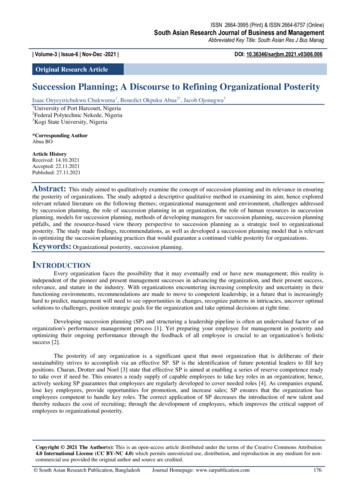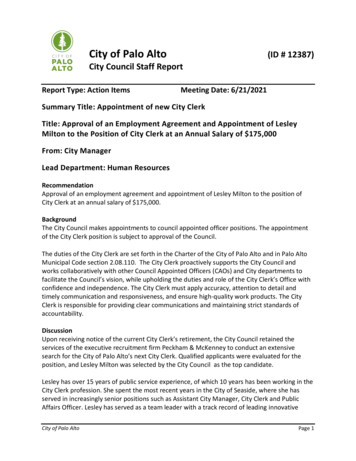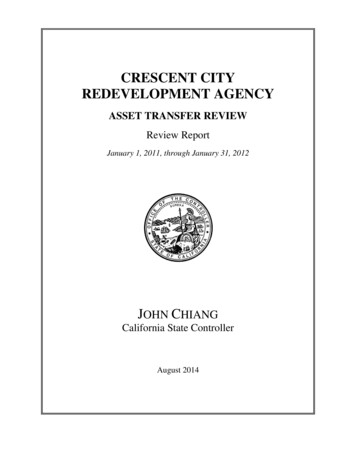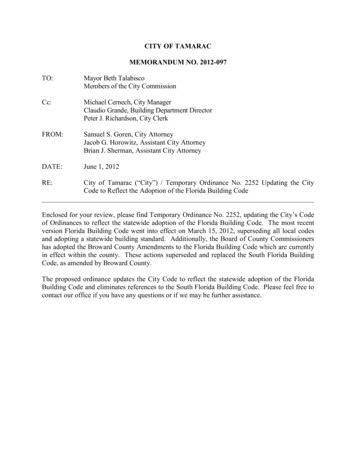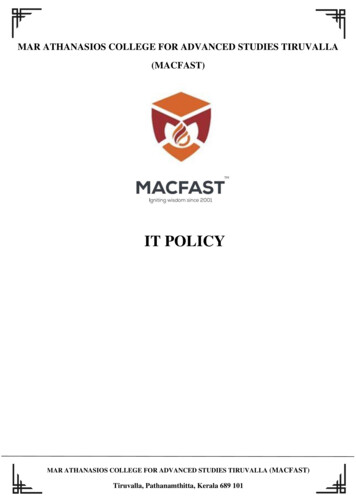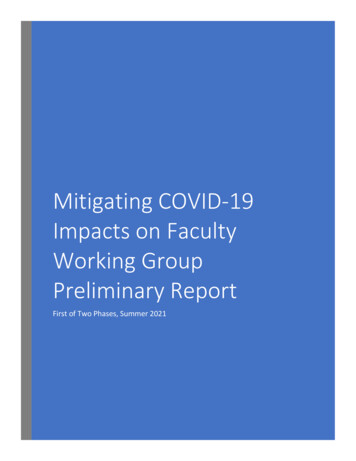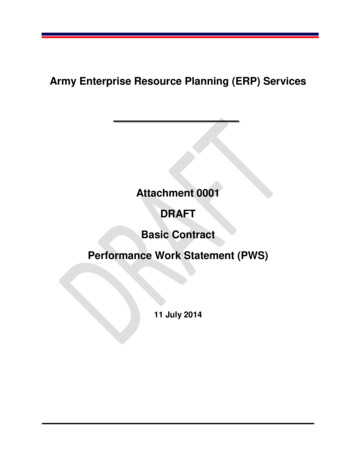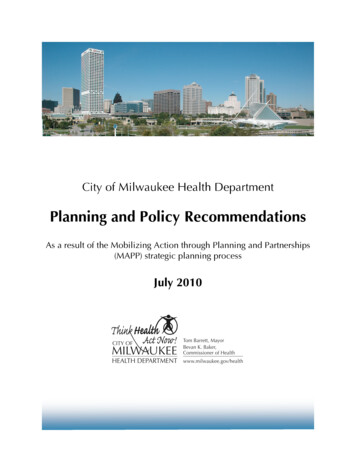
Transcription
City of Milwaukee Health DepartmentPlanning and Policy RecommendationsAs a result of the Mobilizing Action through Planning and Partnerships(MAPP) strategic planning processJuly 2010
Dear Colleagues, Partners, and Friends,Three years ago, the City of Milwaukee Health Department (MHD) began the Mobilizing forAction through Planning and Partnerships process (MAPP). During this period, MHD staff inconjunction with over 150 partners from business, government, academia and social services,conducted a major Community Health Evaluation, developed nine MAPP Action Teams, andproduced a detailed list of potential public health policies and action steps. This policy providesa summary of the Action Team process.Further, the completion of this policy report while a significant achievement does not representthe end of a process. Instead, we believe that this report will provide an excellent framework forcollaborative action between local and state government.Last, the policy recommendations presented in this report will serve as guidance for the MHDand the local public health system as a whole, as we work together toward achieving our goal ofmaking Milwaukee America’s Healthiest City.Sincerely,Bevan K. Baker, FACHECommissioner of HealthCity of Milwaukee Health DepartmentCity of Milwaukee Health Department2www.milwaukee.gov/health
TABLE OF CONTENTSACKNOWLEDGMENTS . . 3EXECUTIVE SUMMARY . 7TIMELINE . . .8SECTION 1. INTRODUCTION . 9MAPP OVERVIEW . . 9KEY ASSESSMENT RESULTS IN MILWAUKEE . 10PROGRESS TOWARD POLICY LEVEL CHANGES 14SECTION 2. PLANNING AND POLICY PHASE . . 15IDENTIFICATION OF NINE ACTION TEAMS . . 15INTEGRATION OF POLICY AND ACTION . . 16ACTION TEAM REPORTS . . 16SECTION 3. POLICY SYNTHESIS AND RECOMMENDATIONS . . 27ANALYSIS OF ACTION TEAM REPORTS . . 27OVERARCHING STRATEGIES . . . . 28POLICY RECOMMENDATIONS . . 29LIMITATIONS . . 30SECTION 4. NEXT STEPS . . 32IMPLEMENTATION OF POLICY . 32EVALUATION . 34SECTION 5. CONCLUSIONS 35APPENDIX . 36APPENDIX A . . 36APPENDIX B . . 52City of Milwaukee Health Department3www.milwaukee.gov/health
ACKNOWLEDGEMENTSThe City of Milwaukee Health Department, in conjunction with a dedicated Steering Committee,was the convening body for this project. Nine Action Teams, comprised of communitystakeholders, were critical to the process, as were the MHD and NACCHO staff and participantswho developed the 2008 Community Health Assessment.Thank you all for your time, knowledge and contributions!MAPP Planning and Policy Phase Steering CommitteeNicole Angresano, Community Impact, United Way of Greater MilwaukeeTony Baez, Council for the Spanish Speaking, Inc.Mary Jo Baisch, University of Wisconsin-Milwaukee College of NursingJean Bell-Calvin, Silver Spring Community Nursing CenterJessica Bergstrom, Center for Urban Population HealthWilliam Borzon, City of Milwaukee Health DepartmentJen Brown, Wheaton Franciscan HealthcareKatherine Brusky, University of Wisconsin-Milwaukee COAQuinton Cotton, Planning Council for Health and Human ServicesDenise Crumble, Plain Talk Program, City of Milwaukee Health DepartmentEmily DeLeo University of Wisconsin-MilwaukeeBrian Farley, Wheaton FranciscanDavid Frazer, Center for Urban Population HealthBrett Fuller, Milwaukee Public SchoolsHoward Garber, Milwaukee Center for IndependenceRobert Harris, Department of Health Services, Southeast RegionJessica Hooberman, Boys & Girls Clubs of Greater MilwaukeeDoran Kemp, Milwaukee Fire DepartmentGary D. Mahkorn, Office of the District Attorney of Milwaukee CountyOlivia Marshall, Chamness GroupEllyn McKenzie, Sixteenth Street Community Health CenterDanyel McNeil, Milwaukee Health DepartmentKaren Michalski, City of Milwaukee Health DepartmentRuthell McKinney, University of Wisconsin-Milwaukee Nursing Center (House of Peace)Kathleen Murphy, Milwaukee Public SchoolsTerry Perry, City of Milwaukee Health DepartmentKris Peterka, Riverwest Health InitiativeBeth Peterman, House of Peace Community Nursing CenterBill Solberg, Columbia St. Mary’sCarla Washington, Froedtert HospitalVirginia Zerpa-Uriona, Center for Urban Population HealthAction TeamsCommunity ChairsNzinga Khalid, Case Manager, Westside Healthcare AssociationMallory O’Brien, Director, Milwaukee Homicide Review CommissionLorraine Lathen, Executive Director, Jump at the Sun ConsultantsRobert Cherry, MATI Redesign Coordinator, Community AdvocatesCity of Milwaukee Health Department4www.milwaukee.gov/health
Virginia Zerpa-Uriona, Specialist of Community-based Research, Center for Urban PopulationHealthKathleen Donovan, HIV Director, Sixteenth Street Community Health CenterRobert Henken, President, Public Policy ForumAmy Kistner, Program Coordinator, Center for Healthy Communities, Medical College ofWisconsinJessica Hooberman, Director of Health and Life Skills, Boys and Girls Club of Greater MilwaukeeCity of Milwaukee Health Department ChairsSara Schubert-Mishefske, Operations Manager, Family and Community HealthTerry Perry, Director, Office of Violence PreventionGeoffrey Swain, Medical DirectorAli Reed, Compliance OfficerSteven Gradus, Laboratory DirectorRaquel Filmanowicz, Operations AdministratorPaul Biedrzycki, Director, Disease Control and Environmental Health ServicesCelestine Grace, Community RelationsKawanza Newson, Public Information OfficerAnna Benton, Director, Family and Community HealthJulie Driscoll, Coordinator, Empowering Families in MilwaukeeAction Team MembersJim Addison, Black Health CoalitionGina Allende, UMOSNicole Angresano, United Way of Greater MilwaukeeElse Ankel, Cambridge Woods Neighborhood AssociationElvira Asuncion, University of Wisconsin-MilwaukeeKenneth Barbeau, City of Milwaukee Housing AuthorityMartha Barry, YWCA Racial Justice ProjectAlderman Robert Bauman, Milwaukee Common Council wirelessRacquel Bell, Brighter FuturesJean Bell-Calvin, Silver Spring Community Nursing CenterReggie Birt, Milwaukee Health ServicesAmy Bittrich, Wisconsin Division of Public Health, Southeastern Regional OfficeJulie Bock, Milwaukee LGBT Community CenterDebra Bonilla, Planned Parenthood of WisconsinWilliam Borzon, City of Milwaukee Health DepartmentSteven Brachman, University of Wisconsin-MilwaukeeTerry Brennan, Social Development CommissionKathleen Brusky, University of Wisconsin-Milwaukee-COAMarcia Caton Campbell, Resilient CitiesClarence Chou, Wisconsin Medical SocietyLeAnn Corning, Milwaukee Public SchoolsJacob Corr, Office of the District Attorney of Milwaukee County, Community ProsecutionDenise Crumble, Plain Talk, City of Milwaukee Health DepartmentPaulina deHaan, Marquette University Law School/Milwaukee Safe StreetsMark Denning, Oneida NationYvette Dobbs, Parents-Plus IncFlorence Dukes, Milwaukee Police DepartmentCity of Milwaukee Health Department5www.milwaukee.gov/health
Martell Echols, Philanthropy Incubator ProjectGenyne Edwards, Greater Milwaukee Foundation - MOSIACWendi Ehrman, Medical College of WisconsinMary Falek, City of Milwaukee Housing AuthorityJohn Fitzgerald, Rotary Club-MIAD/MOSAICJose Flores, Violence Prevention Initiative, Medical College of WisconsinNancy Frank, University of Wisconsin-Milwaukee-Johnson Park InitiativeDavid Frazer, Center for Urban Population HealthBrett Fuller, Milwaukee Public SchoolsKen Germanson, Brighter FuturesMartina Golin-Graves, Mental Health AssociationBenjamin Gramling, Sixteenth Street Community Health CenterTracey Hagedorn, City of Milwaukee Health DepartmentKevin Hardman, Bicycle Federation of WisconsinDonna Harris, University of Wisconsin-MilwaukeeAva Hernandez, Philanthropy Incubator ProjectJeanne Hewitt, University of Wisconsin Milwaukee School of Public Health Planning CommitteeSarah Horn, Milwaukee Common Council (Alderman Kovac’s Office)Barbara Horneribler, Bread of HealingBevelyn Johnson, ANA Enterprise, LLCRon Johnson, Fatherhood Initiative/Marquette University Law SchoolRick Jones, Marquette UniversityAnnie Jurczk, Milwaukee Repertory TheaterLois Kawatski, Wisconsin Department of TransportationDena Klemstein, Milwaukee Homicide Review CommissionJames Koleas, Milwaukee Public SchoolsAlderman Nik Kovac, Milwaukee Common CouncilElizabeth Kraniak, Milwaukee County Department of Health and Human ServicesJoseph Kubisiak, Safe and SoundKenneth Little, Associated BankGary D. Mahkorn, Office of the District Attorney of Milwaukee CountyGlen Mattison, City of MilwaukeeJulia Means, Columbia St. Mary’sJosh Mersky, University of Wisconsin-MilwaukeeMary McCormick, Rotary Club of MilwaukeePeter McMullen, Wisconsin Department of Natural ResourcesKaren Michalski, City of Milwaukee Health DepartmentHenry Monaco, Alzheimer’s AssociationWilliam Morales, Mayors against Illegal Guns, City of Milwaukee Health DepartmentRachel Morgan, Black Health CoalitionJill Mrotek, Wisconsin Department of TransportationMeridith Mueller, Wisconsin Congress for the New Urbanism Organizing CommitteeThelma Newby, SET MinistriesKathy O'Bryant, Milwaukee Public Schools, Head StartDeborah Pasha, Wisconsin Division of Public HealthPaula Penebaker, YWCADavid Petering, University of Wisconsin Milwaukee School of Public Health Planning CommitteeBeth Peterman, University of Wisconsin MilwaukeeNursing Center, House of PeaceJeffrey Polenske, City of Milwaukee EngineerCity of Milwaukee Health Department6www.milwaukee.gov/health
Matthew Polsin, Wisconsin Department of CorrectionsIrmine Reitl, City of Milwaukee Health DepartmentTeresa Rommelfanger, Aurora Health CareJulie Rothwell, United Way of Greater MilwaukeeTrina Salm-Ward, Center for Urban Population HealthDavid Schlabowske, Bicycle Federation of WisconsinHeidi Seymour, Wheaton Franciscan Health CareJeffrey Spence, Milwaukee Metropolitan Sewerage DistrictNatasha Travis, Cream City Medical SocietyKatherine Valentyn, Milwaukee Latino Health CoalitionPang Vang, University of Wisconsin-Milwaukee, House of PeaceCarla Washington, Froedtert HospitalSarah Watson, Wisconsin Department of CorrectionsDavid Weingrod, Milwaukee Public SchoolsStaci Young, Medical College of WisconsinIvy Zamora, Sixteenth Street Community Health CenterVirginia Zerpa-Uriona, Center for Urban Population HealthResearch TeamEric Gass, Public Health Research and Policy Director, City of Milwaukee Health DepartmentLisa Ciazza, Prevention Specialist, Centers for Disease Control and PreventionCourtenay Kessler, Population Health Fellow, University of Wisconsin School of Medicine & PublicHealthRaisa Koltun, Population Health Fellow, University of Wisconsin School of Medicine & Public HealthSamantha J. Perry, Population Health Fellow, University of Wisconsin School of Medicine & PublicHealthRon Cisler, Director, Center for Urban Population HealthPaul Nannis, Consultant, Strategic HealthCare Solutions, LLCSupport for this project was obtained in part through W.K. Kellogg Foundation.Special acknowledgements to Lori Hoffman for her invaluable assistance in coordinating ActionTeam, Steering Committee and Research Team meetings.Special acknowledgements to Kathy Blair whose guidance, support, and commitment to truecommunity-based work informed the entire MAPP process and the development of the currentproject.City of Milwaukee Health Department7www.milwaukee.gov/health
EXECUTIVE SUMMARYThe health of our city is not an isolated phenomenon. It is interwoven with the very social,economic and environmental factors that make our city great but also pose the most significantchallenges. These challenges persist despite strong efforts from public health partners.This report presents a new model for approaching public health. It tries to connect the currentsiloed approach with a more integrated vision of community health and well-being.The Mobilizing Action through Planning and Partnerships (MAPP) process is designed to helpassist local health departments better assess and plan for the health needs of its community.Beginning in 2007, the City of Milwaukee Health Department (MHD) began to replicate the MAPPproject developed by the National Association of County and City Health Officials (NACCHO).The resulting assessment served the dual purpose of meeting the statutory requirement to conducta health assessment every 3-5 years, and guiding the MHD’s development of actions, policies andother strategies to better address the concerns identified through the MAPP process. Results of theassessment are presented in the City of Milwaukee’s 2008 Community Health Assessment.The current process, the Planning and Policy Phase, moves past identification of issues to presentpolicy recommendations and plan for their implementation. This is meant to guide the long-termwork of the MHD. The initial planning process involved the creation of nine Action Teams withguidance from a diverse, representative and community-driven Steering Committee. Action Teamswere tasked with creating a report for action that would address the issues raised in the 2008Community Health Assessment. The process has identified in three overarching strategies to guidepolicy and action:1. Address health equity to achieve equal opportunity for people to live healthy lives.2. Optimize technology use to better connect communities and public health systems.3. Enhance and mobilize partnerships to build on community assets and address communityconcerns.Using these overarching strategies as a platform, policy recommendations were created. Eachoverarching strategy and its corresponding policy recommendations are the beginning of the nextphase and will serve as part of the policy agenda for the MHD.The 2008 Community Health Assessment guided development of action and policy planning. Wenow propose recommendations for policies and actions to guide effective public health work.Implementation is the critical next step and will unfold in the months and years to follow. If weare to achieve our vision of Milwaukee as a model community with healthy, safe, hopeful, andempowered residents, a shift toward policy development and policy advocacy, particularly aroundthe social determinants of health, will be necessary.City of Milwaukee Health Department8www.milwaukee.gov/health
Section 1: IntroductionMilwaukee is Wisconsin’s largest city and the 22nd largest city in the United States. With apopulation of over 604,000 people, it is the business, transportation and cultural hub of our state.It is a city rich in resources and cultural diversity. Milwaukee is also a city of contrasts. It housesmany of Wisconsin’s wealthiest as well as the majority of our state’s poorest residents. AlthoughMilwaukee has our state’s most concentrated health resources, health disparities are the mostpronounced. The current report presents a plan and policy recommendations for addressing thesepublic health concerns, while taking into account our community assets.MAPP OverviewMobilizing for Action through Planning and Partnerships, or MAPP, is a community-widestrategic planning tool for improving community health. It offers a method to help communitiesprioritize public health issues, identify resources for addressing them, and take action. MAPP isnot an agency-focused assessment tool; rather, it is an interactive process that can improve theefficiency, effectiveness, and ultimately the performance of local public health systems. Theprocess was developed through collaboration betweenNACCHO (National Association of County and City Health Officials) and CDC (Center for DiseaseControl and Prevention).1The key phases of the MAPP process include (seefigure 1): Organizing for success and developingpartnershipsVisioningConducting the four MAPP assessmentsIdentifying strategic issuesFormulating goals and strategiesTaking action (planning, implementation,evaluation)MAPP is a paradigm shift in how we think aboutpublic health planning. It is a shift fromFigure 1: Key phases of the MAPP processoperational to strategic planning; from a focus onthe agency to a focus on the community and theentire public health system; from needs assessment to an emphasis on assets and resources; from amedically or service-oriented model to a model that encompasses a broad definition of health; andfrom an “agency knows all” perspective to the belief that “everyone knows something.”Simply put, MAPP is a way of bringing everyone’s collective wisdom together. By gathering all ofthe assets and resources within the community, the community is able to determine how best touse all of the wisdom to create a healthier community. Such a paradigm shift means that MAPP isa ‘new way of doing business.’1National Association of County and City Health Officials. Mobilizing for Action through Planning andPartnerships. ndex.cfm. Accessed February 1, 2010.City of Milwaukee Health Department9www.milwaukee.gov/health
Key Assessment Results in MilwaukeeThe MAPP process began in Milwaukee in 2007. The following summarizes the work of theSteering Committee and Research Team during the Assessment Phase. Greater detail is available inthe City of Milwaukee 2008 Community Health Assessment, available 210.htm.Vision: The Steering Committee developed a shared vision for Milwaukee public health partners.This vision informed the rest of the assessment phase and intends to inform the resulting planning,action, and evaluation. Simply stated:“Milwaukee is a model community with healthy, safe, hopeful and empowered residents.”Four Assessments: The four MAPP Assessments provided the bulk of data that informed thegeneration of strategies and goals. The following pages summarize the results of the assessments:Community Strengths and Themes, Forces of Change, Local Public Health Systems, andCommunity Health Status.1. Community Strengths and Themes AssessmentWhat It Is: This assessment intends to gather community thoughts, opinions and concerns thatprovide insight into the issues of greatest importance to the community. It answers the questionsof: What is important to our community? How is quality of life perceived in our community? What assets do we have that can be used to improve community health?Method: Seventeen in-depth key informant interviews were conducted with representatives ofgovernment, health, community and other various organizations to ascertain their beliefs,perceptions and ideas around Milwaukee’s top health issues and concerns. In addition, eightcommunity focus groups and 24 community interviews were conducted in part throughpartnership with the University of Wisconsin – Milwaukee, College of Nursing students. Responseswere compiled and analyzed for common themes.Overall Findings: Although the interviews and focus groups were conducted across diversecommunities, responses yielded many common themes. Participants identified the followinghealth issues as top concerns: Access to healthcare/under- and uninsured issuesViolence/crime /public safetyUnemployment/job availabilityPoverty/financial stressPoor quality educationRace relations/segregationNutrition/obesityTeen pregnancyEqual opportunity for different races /immigration statusDrugs and drug abuseSexually Transmitted InfectionsCity of Milwaukee Health Department10www.milwaukee.gov/health
This process also identified community assets as including supportive and caringneighbors/residents, diversity, the park system and strong social services.2. Forces of Change AssessmentWhat It Is: The purpose of this assessment is to identify forces – such as trends, factors or events –that are or will be influencing the health or quality of life of the community and local public healthsystem. It also identifies specific threats and opportunities that are generated by these occurrences.Method: To provide input to this assessment, MAPP Steering Committee members were asked tocontribute their ideas to a Forces of Change document which listed trends, factors, and eventsunder different categories as well as threats and opportunities.*Overall Findings: The committee identified trends, factors, events, threats and opportunities relatedto 13 areas: Demographics, Economics, Education, Environment, Health Care, Health Status,Housing, Infrastructure, Politics, Public Health System, Social Issues, Technology, and Violence.Results are summarized in the 2008 Community Health Assessment.3. Local Public Health System AssessmentWhat It Is: This assessment focuses on the “local public health system” broadly defined byNACCHO as “all entities in a community that contribute to the delivery of public health services.”This includes all public, private and voluntary entities, as well as individuals and informalassociations. The assessment rates local performance related to the 10 Essential Public HealthServices that should be available in every community.2Method: The Steering Committee utilized a nationally recognized tool called the National PublicHealth Performance Standards Local Instrument, utilized by the National Public HealthPerformance Standards Program.3 Committee members responded to a series of health-relatedquestions, and the answers were entered into an on-line instrument designed by the Centers forDisease Control and Prevention (CDC) to formulate results.Overall Findings: The following essential health services were rated as strongest for Milwaukee:1. Diagnose & Investigate2. Enforce Laws3. Educate and Empower4. Develop Policies and Plans*Trends are defined as patterns over time, such as population changes, increasing health care costs and poverty.Factors are discrete elements, such as a community’s urban setting or proximity to a major waterway. Events areone-time occurrences, such as state budgets, the passing of new legislation, a hospital closure or a natural disaster.2National Association of County and City Health Officials. Local Public Health Assessment – re/MAPP/phase3LPHSAover.cfm. Accessed February 1, 2010.3Centers for Disease Control and Prevention. National Public Health Performance Standards Program Local PublicHealth Performance Assessment Version ocal v 1 OMB 0920-0555.pdf. Accessed February 1, 2010.City of Milwaukee Health Department11www.milwaukee.gov/health
The City of Milwaukee Health Department (MHD) excelled in addressing health problems andhazards. Highest scores were noted in the areas of laboratory support and designating acoordinator of emergency response.The following services were scored as the weakest:1. Evaluate Services2. Mobilize Partnerships3. Link to Health ServicesThe service identified as needing the most improvement is linking people with health services.According to the assessment, MHD has moderate activity in identifying populations, health serviceneeds, and assessing available services.4. Community Health Status AssessmentWhat It Is: The Community Health Status Assessment is a compilation of state, national and peercommunity data that is collected and analyzed to identify health disparities concerning age,gender, racial and population subgroups.Method: Analysis of existing data sources and five years’ worth of trend data contributed to thecompilation of the Community Health Profile. The Profile was used to help identify strategicissues.Overall Findings: This process yielded an extensive report providing a wealth of information ondifferent health and community factors. Results are summarized in the 2008 Community HealthAssessment.Identified Goals: After in-depth research and analysis, the results of the four assessments werecondensed into a list of nine broader strategic issues. In the MAPP model, strategic issues areframed in the form of a question, and represent the fundamental policy choices or criticalchallenges that must be addressed in order to achieve the vision of Milwaukee as a modelcommunity with healthy, safe, hopeful, and empowered residents. The nine strategic areas werethen developed into the following nine goals aimed at addressing needs and utilizing identifiedstrengths:1. All persons will have access to and utilize culturally and linguistically appropriate, affordable,timely and quality healthcare.2. All persons will live in safety and peace.3. All persons will have opportunity to access resources that afford them the potential to besuccessful financially, vocationally and educationally.4. All persons will have access to comprehensive mental health and ATODA (alcohol, tobaccoand other drugs) treatment and prevention services.5. All persons will benefit from the integration of health into built and natural environments.City of Milwaukee Health Department12www.milwaukee.gov/health
6. All persons will have access to quality, culturally and linguistically appropriate sexual healthinformation and services that will afford them the ability to make healthy and informed sexualhealth related decisions.7. All persons will experience improved relations between persons of all races and will haveopportunities equal to one another.8. All persons will be supported, engaged, treated with respect and have opportunities equal toone another.9. All infants, children and teens will have the opportunity for healthy development.City of Milwaukee Health Department13www.milwaukee.gov/health
Progress toward Policy Level ChangesOver 140 local health departments have completed or are currently replicating NACCHO’s MAPPprocess. Early in the Assessment Phase, MHD identified that it was not satisfied with completing ahealth assessment that stopped at identifying gaps and short-term solutions. Looking to more fullyintegrate a long-term perspective, members of the research team (EG, PN) developed a new nextstep in the process. This next step looks toward developing a core set of policy recommendationsto guide the actions, resources, and direction of the department and its community partners. Itsunderlying belief in the importance of this additional phase, the Planning and Policy Phase, isrooted in the following definition of public policy:“Decisions made in the legislative, executive, or judicial branches of government that areintended to direct or influence the actions, behaviors, or decisions of others.”4The Planning and Policy Phase was also guided by the vision and essential values (namely,communication, accountability, evidence and partnerships) developed by the MAPP SteeringCommittee. We further adopted the perspective that this next step should be collaborative andasset-based. Our understanding of collaboration was informed by work focused on academiccommunity partnerships, proposing that true collaboration requires trust, respect, communicationand mutual understanding of assets and deficits.5Borrowing from the concept of asset-basedcommunity development, our process focused onstarting “with what is present in the community,the capacities of its residents and workers, theassociational and institutional base of the area-not with what is absent, or with what isproblematic, or with what the community needs.”6As described by Kretzmann and McKnight, thisdemands an internal focus that reflects the agendaand capacity for change held in the localcommunity, as well as the need for meaningfulrelationships across the community. Lastly, weadopted MAPP’s definition of the local publichealth system, broadly envisioned as including “allFigure 2: Planning and Policy Phase of MAPPpublic, private and voluntary entities, as well asindividuals and informal associations.”The remainder of this report will address the initial steps of Milwaukee’s MAPP Action Phase,referred to as the Planning and Policy Phase. This work, conducted by the Steering Committee andAction Teams, will guide the MAPP process going forward. Figure 2 summarizes the modifiedMAPP process as envisioned by the MHD and its partners.4Longest BB. Health Policymaking in the United States. 4th ed. Chicago, IL: Health Administration Press; 2006.Gass E. Crossing the threshold: Developing a foundation for university-community partnerships. Research andPractice in Social Sciences. 2008; 4(1): 1-25.6Kretzmann JP, McKnight JL. Building Communities from the Inside Out: A Path Toward Finding and Mobilizinga Community’s Assets. Evanston, IL: Institute for Policy Research; 1993.5City of Milwaukee Health Department14www.milwaukee.gov/health
Section 2: Planning and Policy PhaseIdentification of Nine Action TeamsTo move from assessment to the action phase, the Steering Committee agreed to designate nineAction Teams, each team addressing one of the nine goals created in the 2008 Community HealthAssessment (see page 12-13). It was decided that the Action Phase would be implemented byAction Teams, separate from the Steering Committee. One or more senior managers or programmanagers from City of Milwaukee Health Department (MHD) were assigned to serve as a co-chairof each of the nine Action Teams, with a plan to identify a community co-chair.It was at this point in the process, January 2009 that a leadership change occurred for the MAPPprocess. Kathy Blair, who oversaw the first 18 months of the project, including collecting andanalyzing the data, retired after 30 years of dedicated service to the MHD. Dr. Eric Gass, the newPublic Health Research and Policy Director, assumed day-to-day oversight of the project. Inaddition, MHD received a modest grant from the Kellogg Foundation to incorporate a policydevelopment initiative into the Action Cycle. Funds from this grant supported the time and effortof a policy expert to assist in the development of the process. Former Co
Jacob Corr, Office of the District Attorney of Milwaukee County, Community Prosecution Denise Crumble, Plain Talk, City of Milwaukee Health Department Paulina deHaan, Marquette University Law School/Milwaukee Safe Streets Mark Denning, Oneida Nation Yvette Dobbs, Parents-Plus Inc Florence Dukes, Milwaukee Police Department
